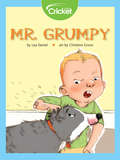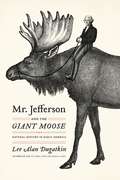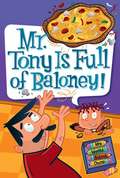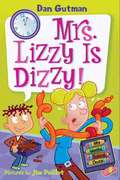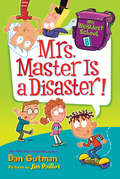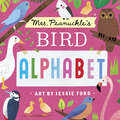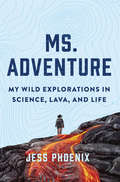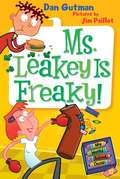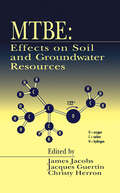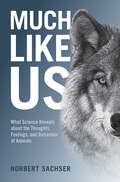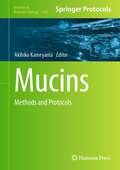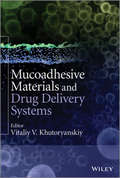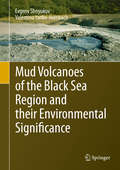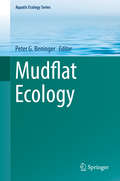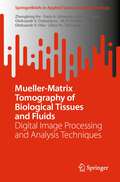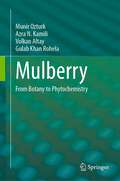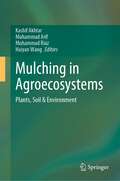- Table View
- List View
Mr. Grumpy
by Lea DanielA grumpy little boy is cheered up by his babysitter, who teaches him the different ways in which dogs and people handle being too hot.
Mr. Harrison Is Embarrassin’! (My Weirder School #2)
by Dan Gutman Jim PaillotMy Weirder School weirder than ever!Mr. Harrison, the tech guy at Ella Mentry School, can fix anything: computers, phones, pencil sharpeners. He can also build anything, like a solar-powered umbrella. What a nerd! But when the power goes out in the school, everyone is yelling and screaming and freaking out in the dark. Can Mr. Harrison save the day?
Mr. Jefferson and the Giant Moose: Natural History in Early America
by Lee Alan DugatkinIn the years after the Revolutionary War, the fledgling republic of America was viewed by many Europeans as a degenerate backwater, populated by subspecies weak and feeble. Chief among these naysayers was the French Count and world-renowned naturalist Georges-Louis Leclerc de Buffon, who wrote that the flora and fauna of America (humans included) were inferior to European specimens. Thomas Jefferson--author of the Declaration of Independence, U. S. president, and ardent naturalist--spent years countering the French conception of American degeneracy. His Notes on Virginia systematically and scientifically dismantled Buffon's case through a series of tables and equally compelling writing on the nature of his home state. But the book did little to counter the arrogance of the French and hardly satisfied Jefferson's quest to demonstrate that his young nation was every bit the equal of a well-established Europe. Enter the giant moose. The American moose, which Jefferson claimed was so enormous a European reindeer could walk under it, became the cornerstone of his defense. Convinced that the sight of such a magnificent beast would cause Buffon to revise his claims, Jefferson had the remains of a seven-foot ungulate shipped first class from New Hampshire to Paris. Unfortunately, Buffon died before he could make any revisions to his Histoire Naturelle,but the legend of the moose makes for a fascinating tale about Jefferson's passion to prove that American nature deserved prestige. In Mr. Jefferson and the Giant Moose,Lee Alan Dugatkin vividly recreates the origin and evolution of the debates about natural history in America and, in so doing, returns the prize moose to its rightful place in American history.
Mr. Tony Is Full of Baloney! (My Weird School Daze #11)
by Dan Gutman Jim PaillotThe weirdness never stops! Oh no! A.J.'s mom just got a job, so he has to go to After School Kids' Kare. And Mr. Tony, the guy who runs it, is crazy. He wants to get into the Guinness Book of World Records by making the world's largest pizza! Will A.J. and the gang be able to tunnel out of the child-care room and escape to freedom? Run for your lives!
Mrs. Frisby and the Rats of Nimh: 50th Anniversary Edition (Literature Unit Ser.literature Unit Seriesliterature Units)
by Robert C. O'BrienSome extraordinary rats come to the aid of a mouse family in this Newbery Medal Award–winning classic by notable children&’s author Robert C. O&’Brien.Mrs. Frisby, a widowed mouse with four small children, is faced with a terrible problem. She must move her family to their summer quarters immediately, or face almost certain death. But her youngest son, Timothy, lies ill with pneumonia and must not be moved. Fortunately, she encounters the rats of NIMH, an extraordinary breed of highly intelligent creatures, who come up with a brilliant solution to her dilemma. And Mrs. Frisby in turn renders them a great service.
Mrs. Jafee Is Daffy! (My Weird School Daze #6)
by Dan Gutman Jim PaillotThe weirdness never stops! <p><p> The new vice principal of Ella Mentry School has some crazy ideas on how to teach kids. A.J. and the gang have to stand on their heads while they do math! They have to take a spelling test underwater! Everybody has to do yoga! Could it possibly get any weirder?
Mrs. Lizzy Is Dizzy! (My Weird School Daze #9)
by Dan Gutman Jim PaillotThe weirdness never stops! Help! With the Recess Enrichment Program, A.J. and the gang have to take classes even during recess! The new teacher, Mrs. Lizzy, teaches how to make balloon animals, how to compost worms, and lots of other weird useless skills that nobody would ever want to know in a million hundred years!
Mrs. Master Is a Disaster! (My Weirdest School #8)
by Dan Gutman Jim Paillot<P> Alexia’s grandmother Mrs. Master makes weird inventions for a living, but A.J. and the gang come up with the weirdest invention of all. And they’re going to make a bazillion dollars from it! Will they succeed? Or will their great big idea be flushed down the drain?<P>Perfect for reluctant readers and word lovers alike, Dan Gutman’s hugely popular My Weird School chapter book series has something for everyone. Don’t miss the hilarious adventures of A.J. and the gang!
Mrs. Peanuckle's Bird Alphabet (Mrs. Peanuckle's Alphabet #5)
by Mrs. PeanuckleFrom the albatross to the zebra finch, Mrs. Peanuckle pulls out her binoculars and introduces toddlers to 26 species of birds from all around the world. Described by a single interesting fact or defining characteristic, each bird proves to be as unique and surprising as the one before. Ever wonder why flamingoes are pink? It’s all those shrimp they eat. Are there birds that can fly backward? Yes, but hummingbirds are the only ones! With colorful, dynamic art, and attention-grabbing text, Mrs. Peanuckle’s birds fly off the page, and in some cases, into the parks and backyards of the children and adults reading this book.Mrs. Peanuckle’s Bird Alphabet is the fifth title in a series of board books celebrating the joy of nature at home and in the backyard, from fresh fruits and vegetables to birds, bugs, and trees.
Ms. Adventure: My Wild Explorations in Science, Lava, and Life
by Jess Phoenix"Jess Phoenix's work encompasses science and representation in such a delightful melding that it could only come from as spry and playful a soul as hers! Open this book and jump into the volcano!" —Patton Oswalt As a volcanologist, natural hazards expert, and founder of Blueprint Earth, Jess Phoenix has dedicated her life to scientific exploration. Her career path—hard earned in the male-dominated world of science—has led her into still-flowing Hawaiian lava fields, congressional races, glittering cocktail parties at Manhattan&’s elite Explorers Club, and numerous pairs of Caterpillar work boots. It has also inspired her to devote her life to making science more inclusive and accessible. Ms. Adventure skillfully blends personal memoir, daring adventure, and scientific exploration, following Phoenix&’s journey from reality television sites deep in Ecuadorian jungles to Andean glaciers, university classrooms to Death Valley in summer. She has even chased down members of a Mexican cartel to retrieve a stolen favorite rock hammer. Readers will delight in her unbelievable adventures, all embarked on for the love of science.
Ms. Leakey Is Freaky! (My Weird School Daze #12)
by Dan Gutman Jim PaillotThe weirdness never stops! <P><P> Oh no! Kids are getting too unhealthy, so Ella Mentry School has hired a health teacher to help the kids eat right and exercise. Ms. Leakey is a real health nut. She makes a punching bag filled with junk food! She designs a robot that smokes and drinks! She opens up a fast food restaurant that sells broccoli burgers! She puts sunscreen on her car!
Mtbe: Effects on Soil and Groundwater Resources
by James Jacobs Jacques Guertin Christy HerronWritten by an expert team of scientists, engineers, and toxicologists, MTBE: Effects on Soil and Ground-Water Resources provides complete in-depth coverage of the assessment and potential remediation strategies of methyl tertiary-butyl ether (MTBE). In addition to a history and overview of fuel oxygenates and MTBE, the book contains the latest info
Much Like Us: What Science Reveals about the Thoughts, Feelings, and Behaviour of Animals
by Norbert SachserWhat really differentiates us from our relatives in the animal world? And what can they teach us about ourselves? Taking these questions as his starting point, Norbert Sachser presents fascinating insights into the inner lives of animals, revealing what we now know about their thoughts, feelings and behaviour. By turns surprising, humourous and thought-provoking, Much Like Us invites us on a journey around the animal kingdom, explaining along the way how dogs demonstrate empathy, why chimpanzees wage war and how crows and ravens craft tools to catch food. Sachser brings the science to life with examples and anecdotes drawn from his own research, illuminating the vast strides in understanding that have been made over the last 30 years. He ultimately invites us to challenge our own preconceptions – the closer we look, the more we see the humanity in our fellow creatures.
Mucins
by Michael A. Mcguckin David J. ThorntonEpithelial mucins are large complex cell surface and secreted glycoproteins produced by mucosal epithelial cells. In, Mucins: Methods and Protocols expert researchers in the field detail many of the methods which are now commonly used to study Mucins. These include methods and techniques for the best approaches to analysing each specific area of mucin biochemistry, physiology and biophysics before providing individual detailed experimental protocols together with troubleshooting and interpretation tips. Written in the highly successful Methods in Molecular BiologyTM series format, chapters include introductions to their respective topics, lists of the necessary materials and reagents, step-by-step, readily reproducible laboratory protocols, and key tips on troubleshooting and avoiding known pitfalls. Authoritative and practical, Mucins: Methods and Protocols is designed to be a useful resource for those entering the mucin field and to facilitate those already studying mucins to broaden their experimental approaches to understanding mucosal biology.
Mucins: Methods and Protocols (Methods in Molecular Biology #2763)
by Akihiko KameyamaThis volume explores the latest advancements in mucin research. The chapters in this book are organized into 8 parts and cover a wide range of topics such as mucin extraction, isolation, physicochemical property analysis, and experimental methods. The chapters also discuss the origins of mucins in jellyfish, feces, saliva and salivary glands, bronchi, stomach, and cervical tract; organic synthesis of peptides glycosylated at specific sites; analysis of mucin gene expression and methylation-specific electrophoresis of genes; imaging of mucin networks by AFM; and experimental methods using supported molecular matrix electrophoresis. Written in the highly successful Methods in Molecular Biology series format, chapters include introductions to their respective topics, lists of the necessary materials and reagents, step-by-step, readily reproducible laboratory protocols, and tips on troubleshooting and avoiding known pitfalls.Cutting-edge and comprehensive, Mucins: Methods and Protocols is a valuable resource for researchers who want to obtain in-depth insight on how to more thoroughly conduct mucin research in their laboratories.
Mucoadhesive Materials and Drug Delivery Systems
by Vitaliy V. KhutoryanskiyMucoadhesion defined as attachment of synthetic or natural materials to mucosal tissues has been widely exploited in pharmaceutical forms. This multi-author book provides an up-to-date account of current research on mucoadhesive materials and drug delivery systems. The introductory section describes the structure and physiology of various mucosal surfaces (oral, nasal, ocular, gastrointestinal and vaginal mucosa). This is followed by chapters on the various methods used to study mucoadhesion and to characterise mucoadhesive properties of various dosage forms. The final section will summarise information on traditional and novel types of mucoadhesive materials, such as chitosan, thiomers, and liposome-based formulations.This book is unique as there is currently no modern book considering mucoadhesion - all other existing books on the topic are either narrowly focused or more than 10 years old. Furthermore, each contributor offers specialist perspectives from a variety of global locations in both industrial and academic research centres.
Mud Builders
by Meish GoldishMeet four master animal mud builders and discover how they work with mud.
Mud Volcanoes of the Black Sea Region and their Environmental Significance
by Evgeny Shnyukov Valentina Yanko-HombachThis exceptionally well-illustrated book at a high scientific level describes mud volcanism as a complex, multidimensional phenomenon requiring multidisciplinary study. Mud volcanoes can be used as “cheap windows” to search for gas-hydrates and other mineral resources in the Black Sea region. Nothing similar has been published before, and as one of its unique features the book includes a vast amount of new data unavailable so far to the western reader. The book includes new data on driving forces, mechanisms, origin, geological and geomorphological features of mud volcanoes as well as new data on composition of solid, gaseous, and liquid components of erupted material. It covers a wide geographic region, and its subjects range from geological to environmental to industrial applications.
Muddy Thinking in the Mississippi River Delta: A Call for Reclamation
by Ned RandolphA free ebook version of this title is available through Luminos, University of California Press's Open Access publishing program. Visit www.luminosoa.org to learn more.Muddy Thinking in the Mississippi River Delta uses the story of mud to answer a deceptively simple question: How can a place uniquely vulnerable to sea level rise be one of the nation's most promiscuous producers and consumers of fossil fuels? Organized around New Orleans and South Louisiana as a case study, this book examines how the unruly Mississippi River and its muddy delta shaped the people, culture, and governance of the region. It proposes a framework of "muddy thinking" to gum the wheels of extractive capitalism and pollution that have brought us to the precipice of planetary collapse. Muddy Thinking calls upon our dirty, shared histories to address urgent questions of mutual survival and care in a rapidly changing world.
Mudflat Ecology (Aquatic Ecology Series #7)
by Peter G. BeningerIntertidal mudflats are distinct, highly-productive marine habitats which provide important ecosystem services to the land-sea interface. In contrast to other marine habitats, and despite a large body of primary scientific literature, no comprehensive synthesis exists, such that the scattered knowledge base lacks an integrated conceptual framework. We attempt to provide this synthesis by pulling together and contextualizing the different disciplines, tools, and approaches used in the study of intertidal mudflats. The editor pays particular attention to relationships between the various components of the synthesis, both at the conceptual and the operational levels, validating these relationships through close interaction with the various authors.
Mueller-Matrix Tomography of Biological Tissues and Fluids: Digital Image Processing and Analysis Techniques (SpringerBriefs in Applied Sciences and Technology)
by Zhengbing Hu Iryna V. Soltys Yuriy A. Ushenko Oleksandr V. Dubolazov M. P. Gorsky Oleksandr V. Olar Liliya Yu. TrifonyukThis book presents experimental investigations and digital image processing, highlighting the interaction of polarized radiation with phase-inhomogeneous and optically anisotropic biological layers. The promising and efficient use of vector-parametric description of the formation of polarization-inhomogeneous object fields is noted. Applications of a set of Mueller-matrix polarimetry methods are highlighted. The book includes- structural and logical scheme of multi-parameter (singular, interference and layer-by-layer Stokes-polarimetric), polarization-correlation study of the structure of distributions of the number of singularities, maps of local contrast of interference distributions and layer-by-layer maps of microscopic polarization azimuth and ellipticity; determination of relationships between changes in the magnitude of statistical parameters characterizing polarization-correlation distributions and pathology of prostate tumors.
Mulberry: From Botany to Phytochemistry
by Munir Ozturk Volkan Altay Azra N. Kamili Gulab Khan RohelaMulberry (Morus spp.) is widely distributed tree taxon found almost in every continent across the globe. Habitat of this plant species is very much diversified, as it is found across all climatic zones ranging from tropical, sub-tropical, temperate, tundra, semi-arid to desert (arid) conditions. It flourishes on all types of landforms; mountains, valleys, plateaus, forests, grasslands, hills, plains and arid lands. Successful utilization of mulberry leaf for silkworm rearing and production of quality cocoons has been studied at length. Now, mulberry is being recognized as a multipurpose plant by most of the countries across the globe. As mulberry is eco-friendly in nature, the propagation of mulberry needs to be done at large scale to address the ecological issues like conversion of arid lands to cultivable lands, eco-restoration of degraded lands, bioremediation of polluted land sites, conservation of water and soil, cleaning the air pollution in urban areas, utilization of mulberry in producing renewable energy in the form of biodiesel. Similarly, there is the need to produce the identified and highly commercially valued pharmaceutical compounds of mulberry under laboratory conditions through in vitro culture based secondary metabolite production through enhanced expression under the stress conditions or in presence of elicitors. Lately protocols have been developed for genetic transformation of mulberry through agrobacterium mediated and particle bombardment mediated gene transfer techniques. Biotechnology based molecular breeding techniques could also be utilized in raising the improved lines through marker assisted selection, soma clonal variations, mutational breeding, somatic hybridization, genome editing and other genetic engineering approaches. Apart from sericulture; mulberry should also be utilized and exploited in other sectors across the globe for additional revenue generation, for livestock maintenance, for environmental safety and in promoting human health. These diversified aspects of mulberry coupled with its economic importance in revenue generation through sericulture, animal husbandry and industrial products has prompted us to prepare this book. It will present a comprehensive account of mulberry plant under 9 chapter headings: introduction, botanical features, ecological features, ecophysiological aspects, interactions and development, molecular aspects, propagation and production, economic importance, and global perspectives as well as future approaches.
Mulberry: Genetic Improvement in Context of Climate Change
by M. K. RazdanMulberry (Morus spp.) is an important horticultural plant in the sericulture industry. It belongs to the family Moraceae. The leaf of mulberry is used to feed the silkworm Bombyx mori L. It is also used as a fodder. Due to its economic and agricultural importance, mulberry is cultivated in many parts of the world. An estimated 60% of the total cost of silk cocoon production is for production and maintenance of mulberry plants. Therefore, much attention is needed to improve the quality and quantity of mulberry leaves. It is vital to increase the production of superior quality mulberry leaves with high nutritive value for the sericulture industry. Although a lot of research is going on in mulberry, very little effort has been made to compile the results of this research in a single book. This book provides an update of recent research works going on in this plant. It describes the taxonomy, conservation of germplasm, genetic diversity of various mulberry species, application of breeding techniques to improve the quality of mulberry, in vitro conservation, application of tissue culture techniques to improve mulberry species, production of haploids and triploids in mulberry and improvement of abiotic stress adaptive traits in mulberry with relevance to adaptiveness to global warming.
Mulching in Agroecosystems: Plants, Soil & Environment
by Haiyan Wang Muhammad Riaz Muhammad Arif Kashif AkhtarThis book provides insights into recent developments in the use of mulching in agroecosystems with emphasis on the major pros and cons. Increase in human population, climatic changes and agricultural intensification have put enormous pressure on soil and water resources. As a result, we are confronted with challenges to enhance nutrient and water use efficiencies and conserve soil organic matter without compromising crop yields and food security. Increasing the soil organic matter (SOM) via residue return increased nutrient availability and soil physical and biological properties. Management practices, such as straw mulching or incorporation, have significant effects on soil health. Straw addition also increases functionality related to carbon and N metabolism via increasing the microbes and thus greatly contributes to CO2 and N2O emissions. However, the co-use of organic and inorganic fertilizer reduces the N2O emission without compromising crop yield. Mulching has long been advocated to conserve soil moisture and increase the efficiency of macro- and micro-nutrients by improving soil physical, chemical, and biological properties. These effects of mulch are translated into better crop yields while improving soil health and quality in the long run. Therefore, the use of mulching techniques is on the rise in organic as well as conventional agriculture. The book is of great interest for researchers, academics, agriculture extensionists, soil and plant scientist, fertilizer industry, farmers, agro-industrial workers, farm managers, NGOs, and climate and civil society activists.
Multi Criteria Analysis in the Renewable Energy Industry
by José Ramón San Cristóbal MateoDecision makers in the Renewable Energy sector face an increasingly complex social, economic, technological, and environmental scenario in their decision process. Different groups of decision-makers become involved in the process, each group bringing along different criteria therefore, policy formulation for fossil fuel substitution by Renewable Energies must be addressed in a multi-criteria context. Multi Criteria Analysis in the Renewable Energy Industry is a direct response to the increasing interest in the Renewable Energy industry which can be seen as an important remedy to many environmental problems that the world faces today. The multiplicity of criteria and the increasingly complex social, economic, technological, and environmental scenario makes multi-criteria analysis a valuable tool in the decision-making process for fossil fuel substitution. The detailed chapters explore the use of the Multi-criteria decision-making methods and how they provide valuable assistance in reaching equitable and acceptable solutions in the selection of renewable energy projects. Common multi-criteria decision-making methods including Analytical Hierarchy Process, PROMETHEE, ELECTRE, TOPSIS and VIKOR are explored in detail with an application case of each method included at the end of each chapter. As such, Multi Criteria Analysis in the Renewable Energy Industry is an ideal resource for those groups of individuals, institutions and administration such as local authorities, academic institutions, environmental groups, and governments that, through their priorities and evaluation systems, have interests at stake and directly or indirectly influence the decision-making process.
